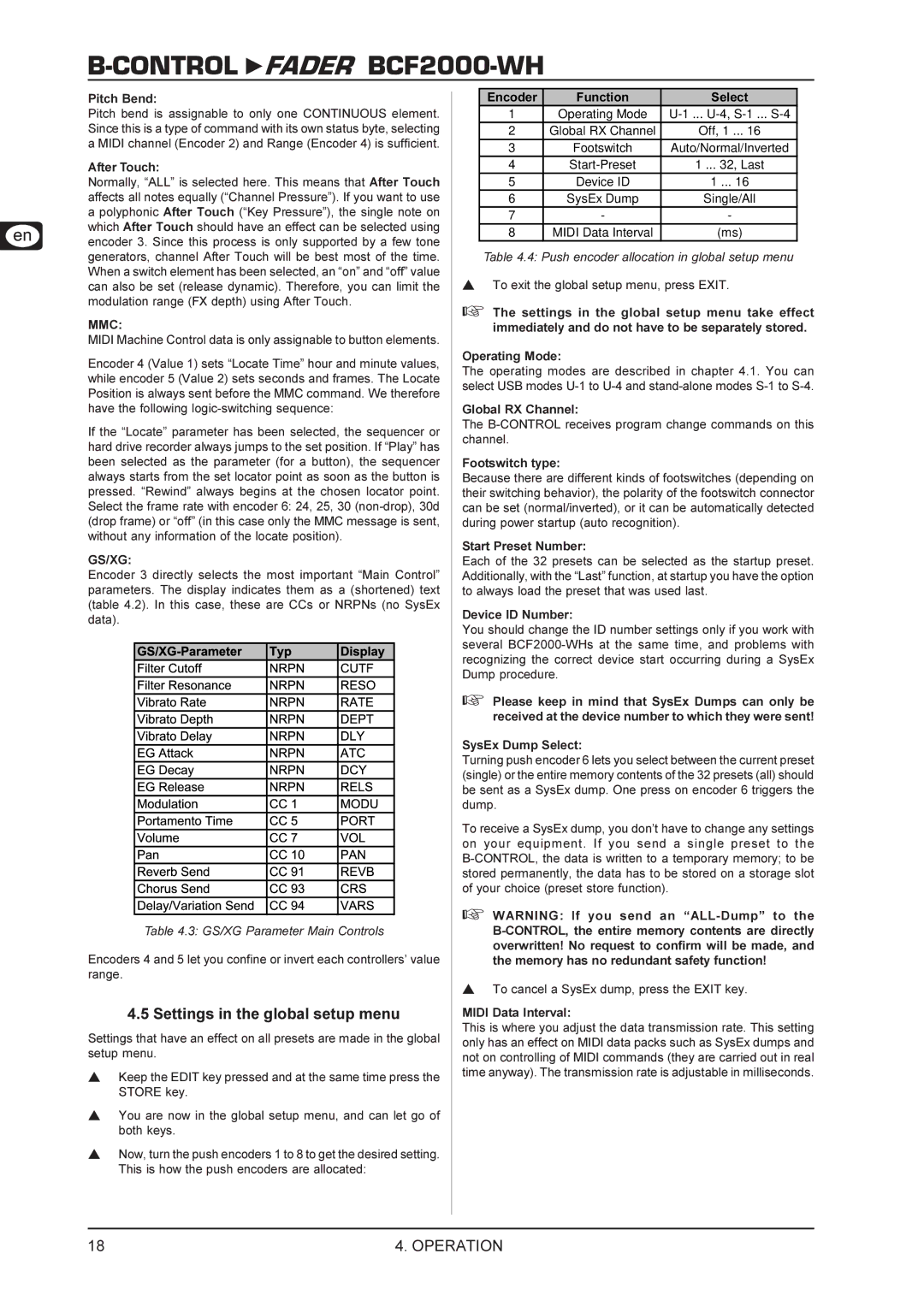
B-CONTROL  FADER
FADER BCF2000-WH
Pitch Bend:
Pitch bend is assignable to only one CONTINUOUS element. Since this is a type of command with its own status byte, selecting a MIDI channel (Encoder 2) and Range (Encoder 4) is sufficient.
After Touch:
Normally, “ALL” is selected here. This means that After Touch affects all notes equally (“Channel Pressure”). If you want to use a polyphonic After Touch (“Key Pressure”), the single note on which After Touch should have an effect can be selected using encoder 3. Since this process is only supported by a few tone generators, channel After Touch will be best most of the time. When a switch element has been selected, an “on” and “off” value can also be set (release dynamic). Therefore, you can limit the modulation range (FX depth) using After Touch.
MMC:
MIDI Machine Control data is only assignable to button elements.
Encoder 4 (Value 1) sets “Locate Time” hour and minute values, while encoder 5 (Value 2) sets seconds and frames. The Locate Position is always sent before the MMC command. We therefore have the following
If the “Locate” parameter has been selected, the sequencer or hard drive recorder always jumps to the set position. If “Play” has been selected as the parameter (for a button), the sequencer always starts from the set locator point as soon as the button is pressed. “Rewind” always begins at the chosen locator point. Select the frame rate with encoder 6: 24, 25, 30
GS/XG:
Encoder 3 directly selects the most important “Main Control” parameters. The display indicates them as a (shortened) text (table 4.2). In this case, these are CCs or NRPNs (no SysEx data).
Table 4.3: GS/XG Parameter Main Controls
Encoders 4 and 5 let you confine or invert each controllers’ value range.
4.5 Settings in the global setup menu
Settings that have an effect on all presets are made in the global setup menu.
sKeep the EDIT key pressed and at the same time press the STORE key.
sYou are now in the global setup menu, and can let go of both keys.
sNow, turn the push encoders 1 to 8 to get the desired setting. This is how the push encoders are allocated:
(QFRGHU | )XQFWLRQ | 6HOHFW |
1 | Operating Mode | |
2 | Global RX Channel | Off, 1 ... 16 |
3 | Footswitch | Auto/Normal/Inverted |
4 | 1 ... 32, Last | |
5 | Device ID | 1 ... 16 |
6 | SysEx Dump | Single/All |
7 | - | - |
8 | MIDI Data Interval | (ms) |
Table 4.4: Push encoder allocation in global setup menu
sTo exit the global setup menu, press EXIT.
+The settings in the global setup menu take effect immediately and do not have to be separately stored.
Operating Mode:
The operating modes are described in chapter 4.1. You can select USB modes
Global RX Channel:
The
Footswitch type:
Because there are different kinds of footswitches (depending on their switching behavior), the polarity of the footswitch connector can be set (normal/inverted), or it can be automatically detected during power startup (auto recognition).
Start Preset Number:
Each of the 32 presets can be selected as the startup preset. Additionally, with the “Last” function, at startup you have the option to always load the preset that was used last.
Device ID Number:
You should change the ID number settings only if you work with several
+Please keep in mind that SysEx Dumps can only be received at the device number to which they were sent!
SysEx Dump Select:
Turning push encoder 6 lets you select between the current preset (single) or the entire memory contents of the 32 presets (all) should be sent as a SysEx dump. One press on encoder 6 triggers the dump.
To receive a SysEx dump, you don’t have to change any settings on your equipment. If you send a single preset to the
+WARNING: If you send an
sTo cancel a SysEx dump, press the EXIT key.
MIDI Data Interval:
This is where you adjust the data transmission rate. This setting only has an effect on MIDI data packs such as SysEx dumps and not on controlling of MIDI commands (they are carried out in real time anyway). The transmission rate is adjustable in milliseconds.
18 | 4. OPERATION |
